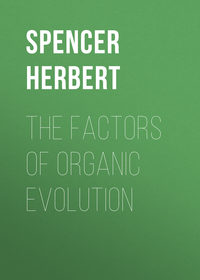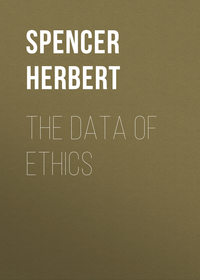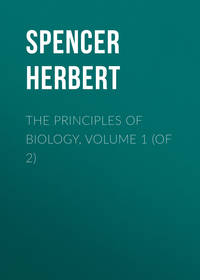 полная версия
полная версияFirst Principles
We have next to consider the consequences of the accompanying loss of velocity. The sensible motion which disappears, cannot be destroyed; but must be transformed into insensible motion. What will be the effect of this insensible motion? Some approach to a conception of it, will be made by considering what would happen were the comparatively insignificant motion of our planet thus transformed. In his essay on “The Inter-action of Natural Forces,” Prof. Helmholtz states the thermal equivalent of the Earth’s movement through space; as calculated on the now received datum of Mr. Joule. “If our Earth,” he says, “were by a sudden shock brought to rest in her orbit, – which is not to be feared in the existing arrangement of our system – by such a shock a quantity of heat would be generated equal to that produced by the combustion of fourteen such Earths of solid coal. Making the most unfavourable assumption as to its capacity for heat, that is, placing it equal to that of water, the mass of the Earth would thereby be heated 11,200 degrees; it would therefore be quite fused, and for the most part reduced to vapour. If then the Earth, after having been thus brought to rest, should fall into the Sun, which of course would be the case, the quantity of heat developed by the shock would be 400 times greater.” Now so relatively small a momentum as that acquired by the Earth in falling through 95,000,000 of miles to the Sun, being equivalent to a molecular motion such as would reduce the Earth to gases of extreme rarity; what must be the molecular motion generated by the mutually-arrested momenta of two stars, that have moved to their common centre of gravity through spaces immeasurably greater? There seems no alternative but to conclude, that this molecular motion must be so great, as to reduce the matter of the stars to an almost inconceivable tenuity – a tenuity like that which we ascribe to nebular matter. Such being the immediate effect of the integration of any two stars in a concentrating aggregate, what must be the ulterior effect on the aggregate as a whole? Sir John Herschel, in the passage above quoted, describing the collisions that must arise in a mutually-gravitating group of stars, adds that those stars “which remain outstanding after such conflicts, must ultimately give rise to circulation of a permanent character.” The problem, however, is here dealt with purely as a mechanical one: the assumption being, that the mutually-arrested masses will continue as masses – an assumption to which no objection was apparent at the time when Sir John Herschel wrote this passage; since the doctrine of the correlation of forces was not then recognized. But obliged as we now are to conclude, that stars moving at the high velocities acquired during concentration, will, by mutual arrest, be dissipated into gases of great tenuity, the problem becomes different; and a different inference appears unavoidable. For the diffused matter produced by such conflicts, must form a resisting medium, occupying that central region of the aggregate through which its members from time to time pass in describing their orbits – a resisting medium which they cannot move through without having their velocities diminished. Every further such collision, by augmenting this resisting medium, and making the losses of velocity greater, must further aid in preventing the establishment of that equilibrium which would else arise; and so must conspire to produce more frequent collisions. And the nebulous matter thus formed, presently enveloping and extending beyond the whole aggregate, must, by continuing to shorten their gyrations, entail an increasingly-active integration and re-active disintegration of the moving masses; until they are all finally dissipated. This, indeed, is the conclusion which, leaving out all consideration of the process gone through, presents itself as a simple deduction from the persistence of force. If the stars have been, and still are, concentrating however indirectly on their common centre of gravity, and must eventually reach it; it is a corollary from the persistence of force, that the quantities of motion they have severally acquired, must suffice to carry them away from the common centre of gravity to those remote regions whence they originally began to move towards it. And since, by the conditions of the case, they cannot return to these remote regions in the shape of concrete masses, they must return in the shape of diffused masses. Action and reaction being equal and opposite, the momentum producing dispersion, must be as great as the momentum acquired by aggregation; and being spread over the same quantity of matter, must cause an equivalent distribution through space, whatever be the form of the matter. One condition, however, essential to the literal fulfilment of this result, must be specified; namely, that the quantity of molecular motion produced and radiated into space by each star in the course of its formation from diffused matter, shall be compensated by an equal quantity of molecular motion radiated from other parts of space into the space which our Sidereal System occupies. In other words, if we set out with that amount of molecular motion implied by the existence of the matter of our Sidereal System in a nebulous form; then it follows from the persistence of force, that if this matter undergoes the re-distribution constituting Evolution, the quantity of molecular motion given out during the integration of each mass, plus the quantity of molecular motion given out during the integration of all the masses, must suffice again to reduce it to the same nebulous form. Here indeed we arrive at an impassable limit to our reasonings; since we cannot know whether this condition is or is not fulfilled. On the hypothesis of an unlimited space, containing, at certain intervals, Sidereal Systems like our own, it may be that the quantity of molecular motion radiated into the region occupied by our Sidereal System, is equal to that which our Sidereal System radiates; in which case the quantity of motion possessed by it, remaining undiminished, our Sidereal System may continue during unlimited time, to repeat this alternate concentration and diffusion. But if, on the other hand, throughout boundless space there exist no other Sidereal Systems subject to like changes, or if such other Sidereal Systems exist at more than a certain average distance from each other; then it seems an unavoidable conclusion that the quantity of motion possessed, must diminish by radiation into unoccupied space; and that so, on each successive resumption of the nebulous form, the matter of our Sidereal System will occupy a less space; until at the end of an infinite time it reaches either a state in which its concentrations and diffusions are relatively small, or a state of complete aggregation and rest. Since, however, we have no evidence showing the existence or non-existence of Sidereal Systems throughout remote space; and since, even had we such evidence, a legitimate conclusion could not be drawn from premises of which one element (unlimited space) is inconceivable; we must be for ever without answer to this transcendent question. All we can say is, that so far as the data enable us to judge, the integration of our Sidereal System will be followed by disintegration; that such integration and disintegration will be repeated; and that, for anything we know to the contrary, the alternation of them may continue without limit.
But leaving this ultimate insoluble problem, and confining ourselves to the proximate and not necessarily insoluble one, we find reason for thinking that after the completion of those various equilibrations which bring to a close all the forms of Evolution we have contemplated, there must still continue an equilibration of a far wider kind. When that integration everywhere in progress throughout our Solar System, has reached its climax, there will remain to be effected the immeasurably greater integration of our Solar System, with all other such systems. As in those minor forms now going on around us, this integration with its concomitant equilibration, involves the change of aggregate motion into diffused motion; so in those vaster forms hereafter to be carried out, there must similarly be gained in molecular motion what is lost in the motion of masses; and the inevitable transformation of this motion of masses into molecular motion, cannot take place without reducing the masses to a nebulous form. Thus we seem led to the conclusion that the entire process of things, as displayed in the aggregate of the visible Universe, is analogous to the entire process of things as displayed in the smallest aggregates. Where, as in organic bodies, the whole series of changes constituting Evolution can be traced, we saw that, dynamically considered, Evolution is a change from molecular motion to the motion of masses; and this change, becoming more active during the ascending phase of Evolution while the masses increase in bulk and heterogeneity, eventually begins to get less active; until, passing through stages in which the integration grows greater, and the equilibrium more definite, it finally ceases; whereupon there arises, by an ulterior process, an increase of molecular motion, ending in the more or less complete dissolution of the aggregate. And here we find reason to believe that, along with each of the thousands of similar ones dispersed through the heavens, our Solar System, after passing through stages during which the motion of masses is produced at the expense of lost molecular motion, and during which there goes on an increasingly active differentiation and integration, arrives at a climax whence these changes, beginning to decline in activity, slowly bring about that complete integration and equilibration which in other cases we call death; and that there afterwards comes a time, when the still-remaining motions of masses are transformed into a molecular motion which causes dissolution of the masses. Motion as well as Matter being fixed in quantity, it would seem that the change in the distribution of Matter which Motion effects, coming to a limit in whichever direction it is carried, the indestructible Motion thereupon necessitates a reverse distribution. Apparently, the universally-coexistent forces of attraction and repulsion, which, as we have seen, necessitate rhythm in all minor changes throughout the Universe, also necessitate rhythm in the totality of its changes – produce now an immeasurable period during which the attractive forces predominating, cause universal concentration, and then an immeasurable period during which the repulsive forces predominating, cause universal diffusion – alternate eras of Evolution and Dissolution. And thus there is suggested the conception of a past during which there have been successive Evolutions similar to that which is now going on; and a future during which successive other such Evolutions may go on.
Let none suppose, however, that this is to be taken as anything more than a speculation. In dealing with times and spaces and forces so immensely transcending those of which we have definite experience, we are in danger of passing the limits to human intelligence. Though these times and spaces and forces cannot literally be classed as infinite; yet they are so utterly beyond the possibility of definite conception, as to be almost equally unthinkable with the infinite. What has been above said, should therefore be regarded simply as a possible answer to a possible doubt. When, pushing to its extreme the argument that Evolution must come to a close in complete equilibrium or rest, the reader suggests that for aught which appears to the contrary, the Universal Death thus implied will continue indefinitely; it is legitimate to point out how, on carrying the argument still further, we are led to infer a subsequent Universal Life. But while this last inference may fitly be accepted as a demurrer to the first, it would be unwise to accept it in any more positive sense.
§ 137. Returning from this parenthetical discussion, concerning the probable or possible state of things that may arise after Evolution has run its course; and confining ourselves to the changes constituting Evolution, with which alone we are immediately concerned; we have now to inquire whether the cessation of these changes, in common with all their transitional characteristics, admits of à priori proof. It will soon become apparent that equilibration, not less than the preceding general principles, is deducible from the persistence of force.
We have seen (§ 85) that phenomena are interpretable only as the results of universally-coexistent forces of attraction and repulsion. These universally-coexistent forces of attraction and repulsion, are, indeed, the complementary aspects of that absolutely persistent force which is the ultimate datum of consciousness. Just in the same way that the equality of action and re-action is a corollary from the persistence of force, since their inequality would imply the disappearance of the differential force into nothing, or its appearance out of nothing; so, we cannot become conscious of an attractive force without becoming simultaneously conscious of an equal and opposite repulsive force. For every experience of a muscular tension, (under which form alone we can immediately know an attractive force,) presupposes an equivalent resistance – a resistance shown in the counter-balancing pressure of the body against neighbouring objects, or in that absorption of force which gives motion to the body, or in both – a resistance which we cannot conceive as other than equal to the tension, without conceiving force to have either appeared or disappeared, and so denying the persistence of force. And from this necessary correlation, results our inability, before pointed out, of interpreting any phenomena save in terms of these correlatives – an inability shown alike in the compulsion we are under to think of the statical forces which tangible matter displays, as due to the attraction and repulsion of its atoms, and in the compulsion we are under to think of dynamical forces exercised through space, by regarding space as filled with atoms similarly endowed. Thus from the existence of a force that is for ever unchangeable in quantity, there follows, as a necessary corollary, the co-extensive existence of these opposite forms of force – forms under which the conditions of our consciousness oblige us to represent that absolute force which transcends our knowledge.
But the forces of attraction and repulsion being universally co-existent, it follows, as before shown, that all motion is motion under resistance. Units of matter, solid, liquid, aëriform, or ethereal, filling the space which any moving body traverses, offer to such body the resistance consequent on their cohesion, or their inertia, or both. In other words, the denser or rarer medium which occupies the places from moment to moment passed through by such moving body, having to be expelled from them, as much motion is abstracted from the moving body as is given to the medium in expelling it from these places. This being the condition under which all motion occurs, two corollaries result. The first is, that the deductions perpetually made by the communication of motion to the resisting medium, cannot but bring the motion of the body to an end in a longer or shorter time. The second is, that the motion of the body cannot cease until these deductions destroy it. In other words, movement must continue till equilibration takes place; and equilibration must eventually take place. Both these are manifest deductions from the persistence of force. To say that the whole or part of a body’s motion can disappear, save by transfer to something which resists its motion, is to say that the whole or part of its motion can disappear without effect; which is to deny the persistence of force. Conversely, to say that the medium traversed can be moved out of the body’s path, without deducting from the body’s motion, is to say that motion of the medium can arise out of nothing; which is to deny the persistence of force. Hence this primordial truth is our immediate warrant for the conclusions, that the changes which Evolution presents, cannot end until equilibrium is reached; and that equilibrium must at last be reached.
Equally necessary, because equally deducible from this same truth that transcends proof, are the foregoing propositions respecting the establishment and maintenance of moving equilibria, under their several aspects. It follows from the persistence of force, that the various motions possessed by any aggregate, either as a whole or among its parts, must be severally dissipated by the resistances they severally encounter; and that thus, such of them as are least in amount, or meet with greatest opposition, or both, will be brought to a close while the others continue. Hence in every diversely moving aggregate, there results a comparatively early dissipation of motions which are smaller and much resisted; followed by long-continuance of the larger and less-resisted motions; and so there arise dependent and independent moving equilibria. Hence also may be inferred the tendency to conservation of such moving equilibria; since, whenever the new motion given to the parts of a moving equilibrium by a disturbing force, is not of such kind and amount that it cannot be dissipated before the pre-existing motions (in which case it brings the moving equilibrium to an end) it must be of such kind and amount that it can be dissipated before the pre-existing motions (in which case the moving equilibrium is re-established).
Thus from the persistence of force follow, not only the various direct and indirect equilibrations going on around, together with that cosmical equilibration which brings Evolution under all its forms to a close; but also those less manifest equilibrations shown in the re-adjustments of moving equilibria that have been disturbed. By this ultimate principle is proveable the tendency of every organism, disordered by some unusual influence, to return to a balanced state. To it also may be traced the capacity, possessed in a slight degree by individuals, and in a greater degree by species, of becoming adapted to new circumstances. And not less does it afford a basis for the inference, that there is a gradual advance towards harmony between man’s mental nature and the conditions of his existence. After finding that from it are deducible the various characteristics of Evolution, we finally draw from it a warrant for the belief, that Evolution can end only in the establishment of the greatest perfection and the most complete happiness.
CHAPTER XVII.
SUMMARY AND CONCLUSION
§ 138. In the chapter on “Laws in general,” after delineating the progress of mankind in recognizing uniformities of relation among surrounding phenomena – after showing how the actual succession in the establishment of different orders of co-existences and sequences, corresponds with the succession deducible à priori from the conditions to human knowledge – after showing how, by the ever-multiplying experiences of constant connections among phenomena, there has been gradually generated the conception of universal conformity to law; it was suggested that this conception will become still clearer, when it is perceived that there are laws of wider generality than any of those at present accepted.
The existence of such more general laws, is, indeed, almost implied by the ensemble of the facts set forth in the above-named chapter; since they make it apparent, that the process hitherto carried on, of bringing phenomena under fewer and wider laws, has not ceased, but is advancing with increasing rapidity. Apart, however, from evidence of this kind, the man of science, hourly impressed with new proof of uniformity in the relations of things, until the conception of uniformity has become with him a necessity of thought, tacitly entertains the conclusion that the minor uniformities which Science has thus far established, will eventually be merged in uniformities that are universal. Taught as he is by every observation and experiment, to regard phenomena as manifestations of Force; and learning as he does to contemplate Force as unchangeable in amount; there tends to grow up in him a belief in unchangeable laws common to Force under all its manifestations. Though he may not have formulated it to himself, he is prepared to recognize the truth, that, being fixed in quantity, fixed in its two ultimate modes of presentation (Matter and Motion), and fixed in the conditions under which it is presented (Time and Space); Force must have certain equally fixed laws of action, common to all the changes it produces.
Hence to the classes who alone are likely to read these pages, the hypothesis of a fundamental unity, extending from the simplest inorganic actions up to the most complex associations of thought and the most involved social processes, will have an à priori probability. All things being recognized as having one source, will be expected to exhibit one method. Even in the absence of a clue to uniformities co-extensive with all modes of Force, as the mathematical uniformities are co-extensive with Space and Time, it will be inferred that such uniformities exist. And thus a certain presumption will result in favour of any formula, of a generality great enough to include concrete phenomena of every order.
§ 139. In the chapters on the “Law of Evolution,” there was set forth a principle, which, so far as accessible evidence enables us to judge, possesses this universality. The order of material changes, first perceived to have certain constant characteristics in cases where it could be readily traced from beginning to end, we found to have these same characteristics in cases where it could be less readily traced; and we saw numerous indications that these same characteristics were displayed during past changes of which we have no direct knowledge. The transformation of the homogeneous into the heterogeneous, first observed by naturalists to be exhibited during the development of every plant and animal, proved to be also exhibited during the development of every society; both in its political and industrial organization, and in all the products of social life, – language, science, art, and literature. From the disclosures of geology, we drew adequate support for the conclusion, that in the structure of the Earth there has similarly been a progress from uniformity, through ever-increasing degrees of multiformity, to the complex state which we now see. And on the assumption of that nebular origin to which so many facts point, we inferred that a like transition from unity to variety of distribution, must have been undergone by our Solar System; as well as by that vast assemblage of such systems constituting the visible Universe. This definition of the metamorphosis, first asserted by physiologists of organic aggregates only, but which we thus found reason to think, holds of all other aggregates, proved on further inquiry to be too wide. Its undue width was shown to arise from the omission of certain other characteristics, that are, not less than the foregoing one, displayed throughout all kinds of Evolution. We saw that simultaneously with the change from homogeneity to heterogeneity, there takes place a change from indefiniteness of arrangement to definiteness of arrangement – a change everywhere equally traceable with that which it accompanies. Further consideration made it apparent, that the increasing definiteness thus manifested along with increasing heterogeneity, necessarily results from increasing integration of the parts severally rendered unlike. And thus we finally reached the conclusion, that there has been going on throughout an immeasurable past, is still going on, and will continue to go on, an advance from a diffused, indeterminate, and uniform distribution of Matter, to a concentrated, determinate, and multiform distribution of it.
At a subsequent stage of our inquiry, we discovered that this progressive change in the arrangement of Matter, is accompanied by a parallel change in the arrangement of Motion – that every increase in the structural complexity of things, involves a corresponding increase in their functional complexity. It was shown that along with the integration of molecules into masses, there arises an integration of molecular motion into the motion of masses; and that as fast as there results variety in the sizes and forms of aggregates and their relations to incident forces, there also results variety in their movements. Whence it became manifest, that the general process of things is from a confused simplicity to an orderly complexity, in the distribution of both Matter and Motion.









